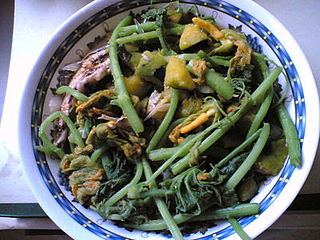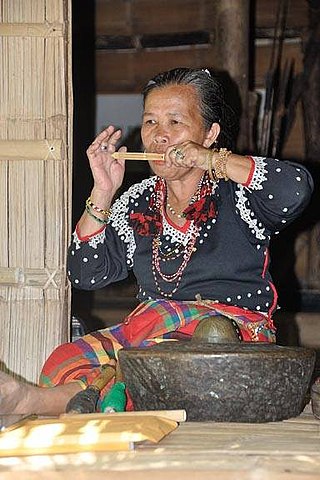Related Research Articles

Hat-making or millinery is the design, manufacture and sale of hats and other headwear. A person engaged in this trade is called a milliner or hatter.

Ilocos Norte, officially the Province of Ilocos Norte, is a province of the Philippines located in the Ilocos Region. Its capital is Laoag City, located in the northwest corner of Luzon Island, bordering Cagayan and Apayao to the east, and Abra to the southeast, and Ilocos Sur to the southwest. Ilocos Norte faces the West Philippine Sea to the west and the Luzon Strait to the north.

Ilocos Sur, officially the Province of Ilocos Sur, is a province in the Philippines located in the Ilocos Region in Luzon. Located on the mouth of the Mestizo River is the capital of Vigan. Ilocos Sur is bordered by Ilocos Norte and Abra to the north, Mountain Province to the east, La Union and Benguet to the south and the South China Sea to the west.

La Union, officially the Province of La Union, is a province in the Philippines located in the Ilocos Region in the island of Luzon. Its capital is the City of San Fernando, which also serves as the regional center of the Ilocos Region.

Kalinga, officially the Province of Kalinga, is a landlocked province in the Philippines situated within the Cordillera Administrative Region in Luzon. Its capital is Tabuk and borders Mountain Province to the south, Abra to the west, Isabela to the east, Cagayan to the northeast, and Apayao to the north. Kalinga and Apayao are the result of the 1995 partitioning of the former province of Kalinga-Apayao which was seen to better service the respective needs of the various indigenous peoples in the area.

The Ilocos Region, designated as Region I, is an administrative region of the Philippines. Located in the northwestern section of Luzon, it is bordered by the Cordillera Administrative Region to the east, the Cagayan Valley to the northeast and southeast, Central Luzon to the south, and the South China Sea to the west.

Calabash, also known as bottle gourd, white-flowered gourd, long melon, birdhouse gourd, New Guinea bean, Tasmania bean, and opo squash, is a vine grown for its fruit. It can be either harvested young to be consumed as a vegetable, or harvested mature to be dried and used as a utensil, container, or a musical instrument. When it is fresh, the fruit has a light green smooth skin and white flesh.

The Asian conical hat is a simple style of conically shaped sun hat notable in modern-day nations and regions of China, Taiwan, parts of Outer Manchuria, Bangladesh, Bhutan, Cambodia, India, Indonesia, Japan, Korea, Laos, Malaysia, Myanmar, Philippines, Nepal, Thailand, and Vietnam. It is kept on the head by a cloth or fiber chin strap, an inner headband, or both.

The Ilocanos, Ilokanos, or Iloko people are the third largest Filipino ethnolinguistic group. They mostly reside within the Ilocos Region, in the northwestern seaboard of Luzon, Philippines. The native language of the Ilocano people is the Ilocano language.

Dinengdeng is a dish of the Ilocano people of the Philippines, similar to pinakbet. It is classified as a bagoong soup-based dish. Unlike pinakbet, dinengdeng contains fewer vegetables more soup base.

Salakót is a traditional lightweight headgear from the Philippines that is commonly used during pre-colonial era up to the present day, used for protection against the sun and rain. Every ethnolinguistic group in the archipelago has their own variant, but they are all usually dome-shaped or cone-shaped and can range in size from having very wide brims to being almost helmet-like. They are made from various materials including bamboo, rattan, nito ferns, and bottle gourd. The tip of the crown commonly has a spiked or knobbed finial made of metal or wood. It is held in place by an inner headband and a chinstrap. The salakot hat also influenced the pith helmet used by European colonizers. Salakot or also spelled as salacot in Spanish and salacco in French is the direct precursor to the pith helmet widely used by European military forces in the colonial era.
The Arts in the Philippines are all the arts in the Philippines, from the beginning of civilization to the present. They reflect a range of artistic influences on the country's culture,including indigenous art. Philippine art consists of two branches: traditional and non-traditional art. Each branch is divided into categories and subcategories.

The Blaan people, are one of the indigenous peoples of Southern Mindanao in the Philippines. Their name could have derived from "bla" meaning "opponent" and the suffix "an" meaning "people". According to a 2021 genetic study, the Blaan people also have Papuan admixture.

The National Living Treasures Award, alternatively known as the Gawad sa Manlilikha ng Bayan, is conferred to a person or group of artists recognized by the Government of the Philippines for their contributions to the country's intangible cultural heritage. A recipient of the award, a National Living Treasure or Manlilikha ng Bayan is "a Filipino citizen or group of Filipino citizens engaged in any traditional art uniquely Filipino, whose distinctive skills have reached such a high level of technical and artistic excellence and have been passed on to and widely practiced by the present generations in their community with the same degree of technical and artistic competence."
Intangible cultural heritage (ICH) includes traditions and living expressions that are passed down from generation to generation within a particular community.

Of the seventeen presidents of the Philippines, a number have shown proficiency in languages other than English and Tagalog.
Federico Caballero is a Filipino chanter of Philippine epic poetry. Caballero is a recipient of the National Living Treasures Award.
Fu Yabing Masalon Dulo, commonly referred to as Fu Yabing, was a Filipino textile master weaver and dyer, credited with preserving the Blaan traditional mabal tabih art of ikat weaving and dyeing. At the time of her death, she was one of only two surviving master designers of the mabal tabih art of the indigenous Blaan people of southern Mindanao in the Philippines.
"Luyag Ko Tan Yaman", also known by its Filipino title "Pangasinan Aking Yaman", and generally referred to as the Pangasinan Hymn, is the official anthem of the province of Pangasinan in the Philippines.
Magdalena Gamayo is a Filipino weaver who is a lead-practitioner of the Ilocano tradition of pinagabel.
References
- ↑ "Official Calendar". Official Gazette of the Republic of the Philippines. Retrieved September 14, 2021.
- 1 2 3 4 "Sagisag Kultura: Teofilo Garcia". CultureEd Philippines (in Tagalog). Philippine Cultural Education Program (PCEP), National Commission for Culture and the Arts. Retrieved September 14, 2021.
- ↑ D’Bayan, Igan (March 1, 2021). "Loren Legarda weaves her tapestry of culture". The Philippine Star. Retrieved September 14, 2021.
- ↑ "Documentary series 'Dayaw' enters 10th season with stories of Filipino culture bearers". ABS-CBN News. March 12, 2021. Retrieved September 14, 2021.
- 1 2 3 Tobias, Maricris Jan. "GAMABA: Teofilo Garcia". National Commission for Culture and the Arts. Retrieved September 14, 2021.
- ↑ Estrella, Fiel (October 10, 2017). "13 indigenous artists who have kept Filipino creativity alive". CNN Philippines. Archived from the original on October 13, 2017. Retrieved September 14, 2021.